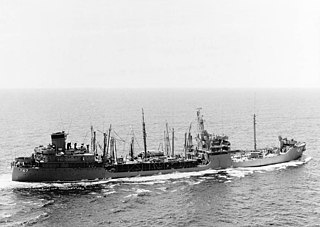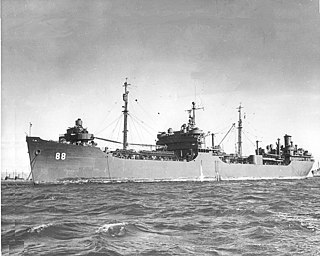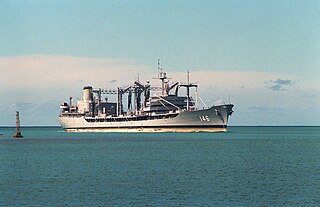
USS Platte (AO-24) was a Cimarron-class oiler serving with the United States Navy, named for the 1836 Platte Purchase that included the Platte Rivers in Iowa, Missouri and Nebraska. Her memorial in Platte County, Missouri honors all four rivers that share the name recorded by Lewis and Clark in 1803.

USS Tulare (AKA-112/LKA-112) was a Tulare-class attack cargo ship in service with the United States Navy from 1956 to 1986. She was sold for scrap in 2011.

USS Kankakee (AO-39) was a Kennebec-class fleet oiler of the United States Navy. The ship was built as SS Colina by Bethlehem Steel Co., Sparrows Point, Maryland, launched on 24 January 1942, sponsored by Mrs. D. A. Little, acquired for the Navy on 31 March through the Maritime Commission from her owner, Socony-Vacuum Oil Company, New York City, and commissioned as Kankakee at Norfolk, Virginia, on 4 May.

USS Neches (AO-47) was a Kennebec-class oiler in the United States Navy during World War II and the Vietnam War. She was the second U.S. Navy ship named for the Neches River in eastern Texas.

USS Tappahannock (AO-43) was a Kennebec-class oiler in the United States Navy that served during World War II, the Korean War, and the Vietnam War. She was sold for scrap in 1987.

USS Saugatuck (AO-75) was a Suamico-class replenishment oiler of the United States Navy.

USS Millicoma (AO-73) was a United States Navy fleet oiler which served in the Pacific Theatre during World War II, winning eight battle stars for her dangerous work. Post-war she was recommissioned and was placed under the control of the MSTS with a civilian crew until finally assigned for disposal in 1987.

The USS Manatee (AO-58)—the second vessel of the United States Navy to bear the name—was a Cimarron-class fleet replenishment oiler named for a river in Florida. Cimarron-class oilers were named after American rivers in the southern United States.

USS Waccamaw (AO-109) was a Cimarron-class replenishment oiler in the United States Navy. She was named after Waccamaw River. The original capacity was 146,000 barrels (23,200 m3).

USS Wabash (AOR-5) was a Wichita-class replenishment oiler in the United States Navy from 1970 to 1994.

USS Marias (AO-57) was a Cimarron-class fleet oiler acquired by the U.S. Navy during World War II. She served her country primarily in the Pacific Ocean Theatre of Operations, and provided petroleum products where needed to combat ships. For performing this dangerous task, she was awarded eight battle stars during World War II, and one campaign star during the Vietnam War for her bravery in combat areas.

USS Taluga (AO-62) was a Cimarron-class fleet oiler acquired by the U.S. Navy during World War II. She served her country primarily in the Pacific Ocean Theatre of Operations, and provided petroleum products where needed to combat ships. For performing this dangerous task in combat areas, she was awarded four battle stars during World War II, four during the Korean War, and six campaign stars during the Vietnam War.

USS Tomahawk (AO-88) was an Escambia-class fleet oiler acquired by the United States Navy for use during World War II. She had the dangerous but necessary task of providing fuel to vessels in combat and non-combat areas primarily in the Pacific Ocean. For her valiant efforts, she received six battle stars during the war.

USS Ashtabula (AO-51) was a Cimarron-class fleet oiler of the United States Navy in service from 1943 to 1991. She survived three wars and was awarded eight battle stars for World War II service, four battle stars for Korean War service, and eight campaign stars for Vietnam War service. In the mid-1960s Ashtabula became the lead ship of her class, when she and seven other Cimarron-class oilers were lengthened ("jumboized"). She has been the only U.S. Navy ship to bear the name Ashtabula, after the City of Ashtabula which was named after the Ashtabula River in northeast Ohio.

USS Procyon (AF-61) was an Alstede-class stores ship in service with the United States Navy from 1961 to 1972, following commercial service from 1943 to 1961. She was scrapped in 1986.

USS Neosho (AO-143) was the lead ship of her class of fleet oilers of the United States Navy, in service from 1954 to the early 1990s.

USS Navasota (AO-106) was an Ashtabula-class replenishment oiler that served in the U.S. Navy from 1946 to 1973, then transferred to the Military Sealift Command to continue service as United States Naval Ship USNS Navasota (T-AO-106) until taken out of service in 1992. Navasota was sold for scrapping in 1995. She was the only U.S. Navy ship to bear the name Navasota.

USS Mispillion (AO-105) was an Ashtabula-class oiler that served in the United States Navy from 1945 to 1974. She was then transferred to the Military Sealift Command to continue in non-commissioned service as United States Naval Ship USNS Mispillion (T-AO-105), in which capacity she served until 1994. Thus far, Mispillion has been the only U.S. Navy ship to bear the name.

Kawishiwi (AO-146) was a Neosho-class replenishment oiler of the United States Navy, in service between 1955 and 1992.

USS Hassayampa was a Neosho-class fleet replenishment oiler in service with the United States Navy, and the United States Merchant Marine from 1955 to 1991. A veteran of the Vietnam and First Gulf War, she served for 36 years before being laid up in the Suisun Bay Reserve Fleet in California. Her keel was laid on 13 July 1953.






















